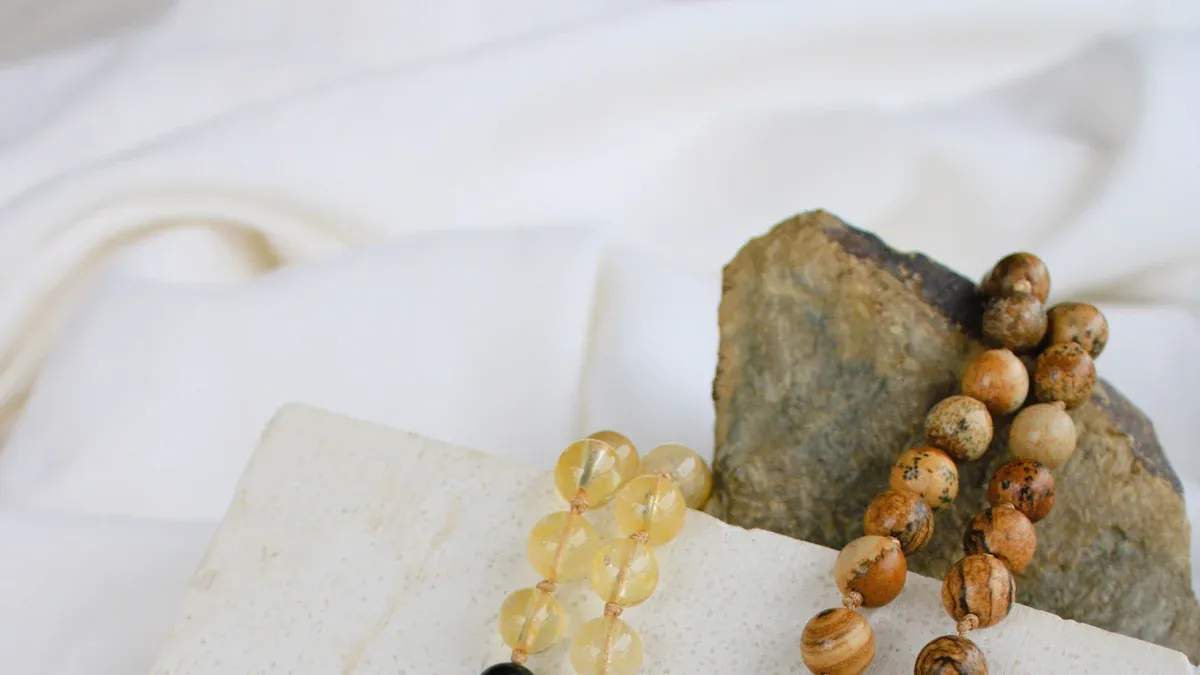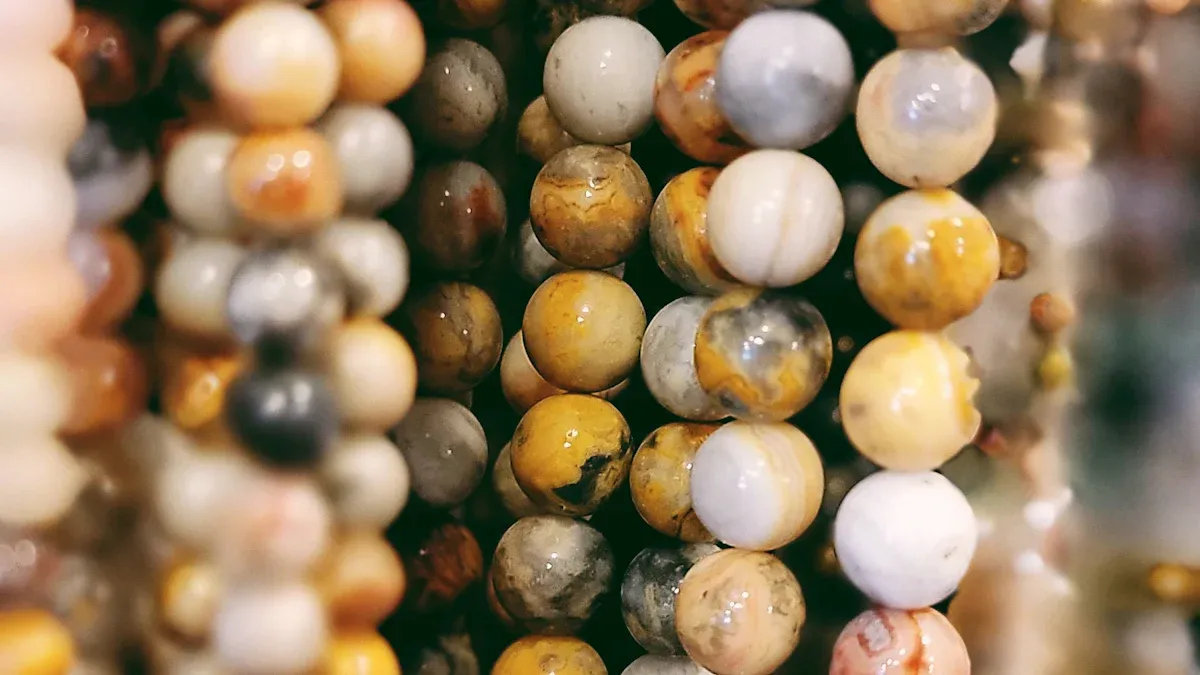
You can help by using Eco-Friendly Prayer Beads. It does not matter where you come from or what you know. Many people now pick sustainable spiritual products.
About 18% of new buyers in North America chose eco-friendly incense and other sustainable spiritual items after they were released.
If you pick natural materials or do a simple DIY project, you help cut down on waste. You also support fair practices. These choices make your prayer beads special to you. They show you care about the planet. You do not need special skills. You just need to want to help.
Key Takeaways
Picking eco-friendly prayer beads helps cut down on waste. It also supports good ways to care for the Earth. This choice shows you care about the planet.
Eco-friendly materials, like natural woods and seeds, help save nature. They also lower pollution. These materials help keep air and water clean.
Making your own prayer beads is a fun project. You can reuse old things and make something special.
When you buy prayer beads, look for brands that use fair ways to get materials. They should also use packaging that can be recycled. This helps support fair actions.
Taking care of your prayer beads makes them last longer. Clean them often and handle them gently. This keeps them pretty and important.
Why Eco-Friendly Prayer Beads
Sustainability Matters
When you pick Eco-Friendly Prayer Beads, you help the planet. These beads use materials that can grow back. They do not hurt the earth as much. You help make less trash and save nature. Regular prayer beads often use things that do not break down. Some come from places that do not care about the earth. Eco-Friendly Prayer Beads are a better choice for nature.
Tip: If you choose beads made from natural or recycled things, you can help cut down on pollution in the air and water.
Here are some ways Eco-Friendly Prayer Beads help the earth:
Use materials that can grow back
Make less trash
Save nature
Make less pollution
Help keep air and water clean
Personal and Global Benefits
Eco-Friendly Prayer Beads help you and the world. You support fair work and fair pay. Many brands work with people who make beads by hand. They make sure workers are safe and paid well. You help keep animals safe by picking beads from good sources.
Benefit |
Description |
|---|---|
Eco-Friendly Nature |
Made from things that can grow back, so they do not hurt the earth much. |
Waste Reduction |
Helps make less trash by using things that break down. |
Conservation of Resources |
Saves nature by using materials that do not run out. |
Lower Carbon Footprint |
Usually made in ways that make less pollution. |
Pollution Reduction |
Helps keep the air and water cleaner. |
Wildlife Habitat Protection |
Helps keep animal homes safe by using good materials. |
Promotes Ethical Practices |
Supports fair and good ways to make beads. |
Community Inspiration |
Shows others how to care for the earth and people. |
You can show your friends and family how to make good choices. You show that it is important to care for people and the earth. Eco-Friendly Prayer Beads help you link your spiritual life to helping the world.
Materials for Eco-Friendly Prayer Beads

Natural Woods
You can pick prayer beads made from natural woods. These woods come from trees that grow back fast. They do not hurt the earth. Sandalwood and olivewood are two popular choices. Sandalwood smells nice and is special for many people. Olivewood looks pretty and comes from safe trees. These trees are not in danger. People often collect these woods in ways that protect forests. This helps keep forests healthy for the future.
Type of Wood |
Sustainability Aspect |
Sourcing Practices |
|---|---|---|
Sandalwood |
Spiritual and calming |
Managed forests |
Olivewood |
Sustainable, not endangered |
Mediterranean, responsible sourcing |
Brands like Bali Malas and Japa Mala Beads use these woods. They make sure their beads are good for the earth. They also care about the people who make them.
Tip: When you buy wood beads, check if they say "sustainably sourced" or "from managed forests."
Seeds and Nuts
Seeds and nuts are another good choice for Eco-Friendly Prayer Beads. These come from plants and trees that keep growing after picking. You can find beads made from rudraksha, lotus seeds, bodhi seeds, açai seeds, kukui nut, tagua nut, and more. Each kind has its own look and story.
Rudraksha: Used in India for mala necklaces.
Lotus seeds: Stand for purity.
Bodhi seeds: Mean wisdom.
Açai seeds: Come from the Amazon.
Kukui nut: Shiny and brown.
Tagua nut: Looks like ivory but does not hurt animals.
These seeds and nuts are safe for the earth. People collect them in ways that let plants keep growing. Using seeds means you do not use plastic or other bad stuff.
Recycled and Upcycled
You can also choose prayer beads made from recycled or upcycled things. Some brands use old glass, wood, or jewelry parts. This helps make less trash and saves energy.
Benefit |
Description |
|---|---|
Waste Reduction |
Less trash goes to landfills. |
Energy Conservation |
Uses less energy than making new materials. |
Resource Conservation |
Saves trees and other natural resources. |
Carbon Footprint |
Makes less pollution. |
Pollution Prevention |
Keeps harmful chemicals out of the earth and water. |
When you pick recycled beads, you help the earth in many ways. You also support brands that care about nature. Bali Malas and Japa Mala Beads use renewable things. They make beads that last a long time.
How to Choose or Make Eco-Friendly Prayer Beads

Identifying Sustainable Options
You can find many prayer beads that claim to be sustainable. To make sure you choose the right ones, look for certain signs. Brands like Prabhuji's Gifts and Unspoken Elements focus on ethical sourcing and eco-friendly packaging. They often share details about where their materials come from and how they treat workers.
Here are some important criteria to help you spot truly sustainable prayer beads:
Criteria |
Description |
|---|---|
Material Authenticity |
Genuine materials feel natural, show small differences, and have real textures. |
Quality Craftsmanship |
Beads should be even in size, with strong knots and sturdy thread. |
Traditional Features |
Many authentic malas have 108 beads and use materials like rudraksha or sandalwood. |
Reputable Specialty Stores |
Good sellers can tell you about the source and how the beads are made. |
Direct from Artisans |
Artisans use traditional skills and gather materials in ethical ways. |
You can also check for certifications and labels. These show that a brand meets high standards for the environment and workers. Here are some common certifications:
Certification/Label |
Description |
|---|---|
Certified B Corporation |
Company meets high social and environmental standards. |
Fair Trade Federation |
Ensures fair pay and safe work for makers. |
The Rainforest Alliance |
Focuses on protecting nature and using good farming methods. |
Cradle to Cradle |
Product is made for reuse and recycling. |
Organic Content Standard |
Checks if the product uses real organic materials. |
Global Recycled Standard |
Makes sure products use recycled materials. |
USDA Organic |
Meets organic farming rules. |
Regenerative Organic Certified |
Uses farming that helps the earth heal. |
MADE SAFE® |
Free from harmful chemicals. |
When you shop, look for artisan-made and fair trade beads. These support real people and help keep traditions alive. Many brands use recyclable packaging, such as recycled paper, cardboard, or organic cotton pouches. This helps cut down on waste.
Tip: Brands that use solar energy or support traditional communities often share this on their websites. This shows they care about the planet and people.
You can also check if brands are open about their suppliers and factories. Some let you track where your beads come from. Brands with direct ties to artisans often share more about their process.
DIY Guide
You can make your own Eco-Friendly Prayer Beads at home. This is a fun way to reuse old materials and create something special. You do not need fancy tools or skills. Here is a simple step-by-step guide to making beads from recycled paper and natural items:
Materials Needed
Materials Needed |
Quantity |
|---|---|
Large beads |
5 |
Medium beads |
29 |
Seed beads |
36 |
Cross or pendant |
1 |
Crimp tubes |
2 |
Wire |
20-24 in |
You can also use:
Old wrapping paper or magazines
Pencils and rulers
Scissors
Skewer or dowel
Glue sticks
Foam block
Varnish and paintbrush
Tools Required
Tools Required |
Quantity |
|---|---|
Chain nose pliers |
1 |
Side (flush) wire cutters |
1 |
Step-by-Step Instructions
Take one cup of shredded paper. Make sure it is only paper.
Put the paper in a blender. Add warm water and blend until it turns to pulp.
Pour the pulp into a strainer. Press out most of the water.
Crush 1/4 cup of dried rose petals and mix them into the pulp.
Add 1-2 teaspoons of glue. Mix until it forms a dough.
Pinch out a small amount and roll it into a ball.
Squeeze out extra water. The bead should be damp, not wet.
Slide the bead onto a bamboo skewer.
Let the beads dry in a cool, dry place for 24-36 hours.
Halfway through, reshape the beads if needed.
When dry, coat with glue for shine.
After the glue dries, string the beads on thread or wire.
Note: You can use seeds, nuts, or wood beads instead of paper for a different look.
Making your own beads lets you choose every part of the process. You can use solar energy to dry your beads if you have access to sunlight. This saves power and helps the earth.
Where to Buy
You can find Eco-Friendly Prayer Beads in many places. Look for stores that support artisans and use fair trade practices. Some brands use recyclable packaging, like recycled paper or organic cotton bags, to reduce waste.
Popular online and physical stores include:
Etsy: Offers many styles and price ranges from different artisans.
Full Circle Beads: Sells a wide range of eco-friendly prayer beads.
Prabhuji's Gifts and Unspoken Elements: Known for ethical sourcing and eco-friendly packaging.
Aid Through Trade: Employs artisans in Nepal and uses high-quality materials.
Bead the Change: Sells recycled glass beads made by artisans in Ghana.
When you buy from these brands, you help support traditional communities. This keeps cultural skills alive and gives artisans a fair income. Handmade crafts tell unique stories and connect you to the people who made them. Buying from local artisans also helps their families and towns.
Packaging Option |
Description |
Environmental Benefit |
|---|---|---|
Recycled Plastic |
Made from waste plastics, durable and light. |
Reduces carbon emissions by 30%. |
Recycled Paper/Cardboard |
Used for boxes and wraps, saves trees. |
Lowers carbon emissions by about 40%. |
Biodegradable Peanuts |
Plant-based filler, breaks down quickly. |
Decomposes much faster than foam. |
Organic Cotton |
Used for pouches, grown without chemicals. |
Good for the earth and people. |
Tip: When you buy, look for brands that share their story and show how they help their workers and the planet.
Supporting traditional communities helps keep their culture strong. It also brings jobs and pride to local people. When you choose Eco-Friendly Prayer Beads, you help both the earth and the people who care for it.
Caring for Your Prayer Beads
Maintenance Tips
You can keep your eco-friendly prayer beads in great shape with a few simple habits. Start by handling your beads with clean hands. This keeps oils and dirt from building up on the surface. Always treat your beads with care. Avoid tugging or pulling on them, as this can weaken the thread or cord.
Store your prayer beads in a soft, breathable pouch or a dedicated box. This protects them from dust and damage. Keep them away from direct sunlight, which can fade colors, and avoid moisture that can harm wood or seed beads. If your beads have a tassel, gently smooth and comb it to keep it neat. You can trim the ends if they start to fray.
Regular cleaning helps your beads stay beautiful and spiritually vibrant. For a natural cleanse, try smudging your beads with white sage. Burn the sage and let the smoke drift over your beads. If you do not have sage, you can use natural incense like frankincense or sandalwood. This traditional method refreshes both the look and energy of your beads.
Tip: Use your prayer beads often during meditation. Regular use helps prevent dust from settling and keeps their energy strong.
Longevity
You can make your eco-friendly prayer beads last for many years by following a few key steps. Avoid wearing your beads during physical activities, such as sports or chores. This prevents breakage and keeps the beads from getting scratched or chipped. Do not expose your beads to water, especially if they are made from wood or seeds, as moisture can cause swelling or cracking.
Handle gemstone or crystal beads gently. These materials can chip if dropped or knocked against hard surfaces. Refrain from wrapping your mala around your wrist for long periods, as this can stretch the cord. Never wear your beads while sleeping, since this can cause stress on the thread and beads.
You can keep your beads spiritually pure by storing them in a special place, like a pouch or box, when not in use. Cleanse them regularly to restore their energy. With these habits, your prayer beads will stay beautiful and meaningful for a long time.
Eco-friendly prayer beads are easy for anyone to use. They help you care for the earth and grow spiritually. You can make these beads at home or buy them. Some types, like Sacrifice Beads, are good for kids and easy to carry.
You can keep them in your pocket.
Move a bead each time you do something kind. This makes using them fun for everyone.
Picking eco-friendly prayer beads helps you feel close to nature. It also teaches you to think before you buy things. Your choice helps the planet and shows others how to help too. Make or buy eco-friendly prayer beads today and join a group that cares. 🌱
FAQ
What makes prayer beads eco-friendly?
Eco-friendly prayer beads use natural, renewable, or recycled materials. You help the planet by choosing beads made from wood, seeds, or upcycled glass. These beads break down safely and support fair work for artisans.
Can you use eco-friendly prayer beads for any tradition?
Yes! You can use eco-friendly prayer beads for many spiritual paths, including Buddhism, Christianity, Hinduism, Islam, and Taoism. The materials and design may change, but the purpose stays the same.
How do you clean eco-friendly prayer beads?
Wipe your beads gently with a soft, dry cloth. For a deeper clean, use a slightly damp cloth. Avoid harsh chemicals or soaking. You can also refresh your beads by smudging with sage or incense.
Where can you buy eco-friendly prayer beads?
You can find eco-friendly prayer beads online or in local shops. Look for brands that use fair trade, recycled, or natural materials. Check for clear information about how the beads are made and packaged.
Can kids use eco-friendly prayer beads?
Kids can use eco-friendly prayer beads safely. Choose beads with smooth edges and strong cords. Some types, like Sacrifice Beads, work well for children. These beads help kids learn kindness and mindfulness.
See Also
How Ancient Taoism Used Talismans for Blessings
Exploring the Global Influence of Prayer Beads in Different Cultures






